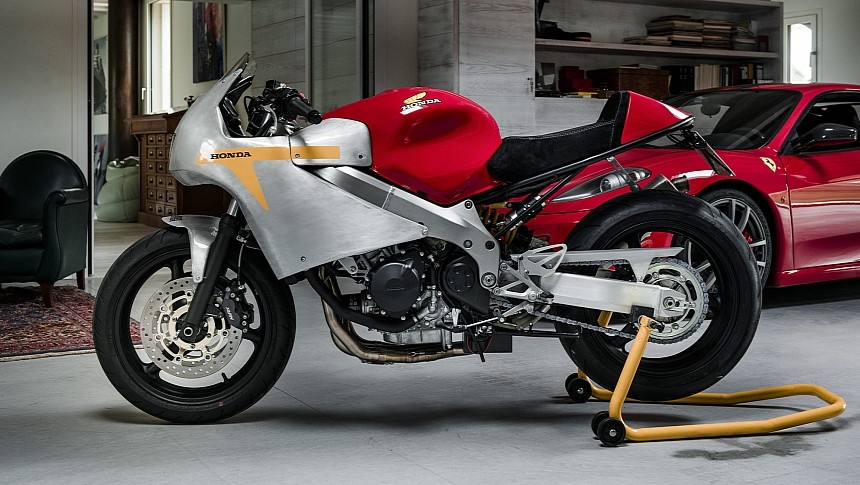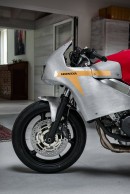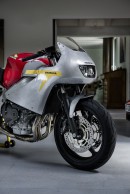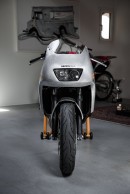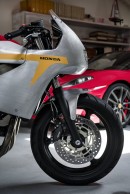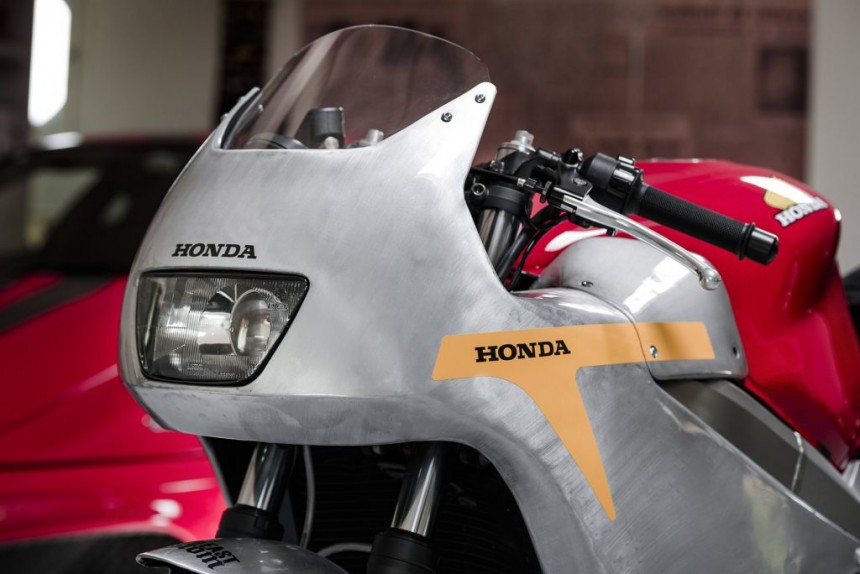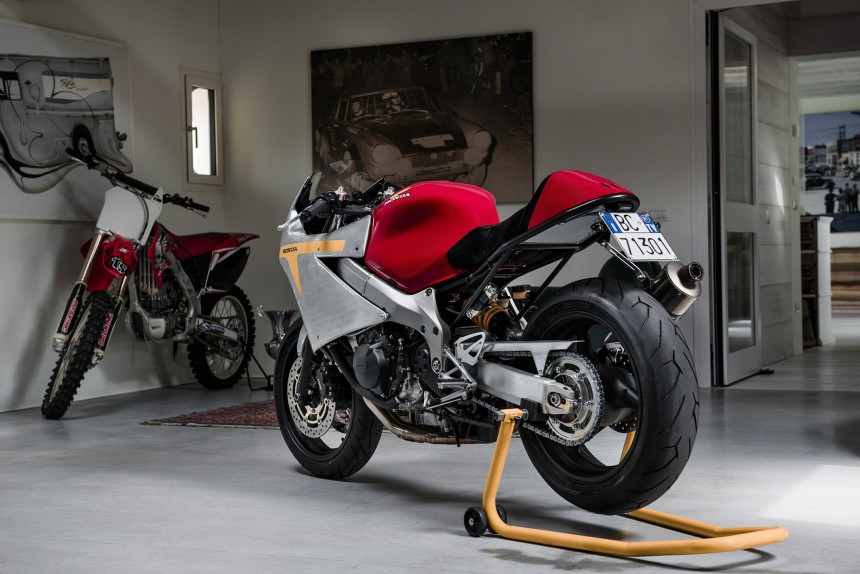Some custom bikes signify a whole lot more to their owners than the sum of their parts. This can be attributed to several factors, but the mouth-watering project pictured below was put together with a very specific goal in mind. It is the work of Diego and Riccardo Coppiello, the fraternal duo running North East Custom (NEC) over in Padua, Italy. Their client was a 62-year-old motorcycle collector with great taste and a life-long ambition.
He wanted to attend the Isle of Man TT as a spectator, but simply taking a flight with a short stop in the UK wasn’t exciting enough. To get the most novel experience he could out of the trip, the guy sought to ride all the way from Padua to Calais, cross the English Channel, and continue riding to Liverpool. There, a ferry was to take him to his destination, more than 1,250 miles (2,000 km) from his hometown.
Altogether, the journey was going to take three days and some very long hours in the saddle, so a comfortable machine was absolutely essential. The bike had to also look good, of course, and this wouldn't be an issue given who was entrusted with this commission. As their starting point, NEC used a Honda CBR600F from the model-year 2001.
With its sixteen-valve 599cc four-banger delivering up to 109 hp and 48 pound-feet (65 Nm) of torque, the CBR was a pretty solid basis from a mechanical standpoint. Its original styling was nothing to write home about, though, and North East Custom looked for ways to give it a bit more visual appeal without having to sacrifice any of its practicality.
Taking cosmetic influences from the Japanese marque’s iconic RC race bikes of yore, the Coppiello brothers deleted all the stock bodywork besides the fuel tank. Then, the real fun began with some intricate fabrication and thin sheets of aluminum. Using traditional metal-shaping techniques, the Italians fashioned a stunning front fairing that looks a lot classier while still offering a fair bit of wind deflection.
It’s topped with a clear windshield, placed around a Yamaha FZR’s headlamp, and secured in place via tailor-made mounting hardware. One may also find a sporty fender lower down and a pair of bespoke side panels further back, with the latter creating visual continuity between the factory gas tank and custom bodywork. All the front-end garments feature a brushed alloy finish we can’t seem to get enough of.
Believe it or not, this was the first time the Coppiellos worked with aluminum, which speaks volumes about their natural inclination toward metal fabrication. The CBR600F’s revised rear end is incredibly enticing, as well, sporting a new loop-style subframe built from scratch. An unobtrusive license plate bracket is attached to the rearmost portion of the tubing, complete with aftermarket LED turn signals.
Up top, we come across a simple, yet stunning cafe racer tail section. It carries twin LED taillights at the back, while stashing part of the motorcycle’s electronics well out of sight within. NEC placed a handmade seat with black suede upholstery and thick padding for comfort during long-distance rides. As the client didn’t wish to break the bank here, items such as the standard brakes, wheels, and suspension have all been retained.
The CBR’s inline-four powerhouse was potent enough in stock form, too, so it remained internally unchanged during North East Custom’s makeover. On the other hand, the OEM exhaust system got taken out of the equation, making room for a premium four-into-one replacement from Akrapovic. Now, the paintwork worn by this specimen is where the RC influence really kicked in.
We’ve already mentioned the brushed aluminum finish adorning the fairing, front fender, and side panels, but the fuel tank and tail were both painted red. Retro-style Honda graphics can also be spotted on the tank, while yellow-ochre highlights have been laid onto the fairing and accompanying panels. With everything nicely buttoned up and ready to go, the owner was summoned at the shop to meet his new ride.
He was understandably stoked with the result and couldn’t wait to embark on his lengthy road trip to the Isle of Man. The timing was quite excellent, as well, because the reworked Honda was finished in time for the 2019 Tourist Trophy and the following two years would see the event canceled for reasons we all know of. After a trouble-free trip there and back, NEC’s customer was even more intrigued than before.
Diego and Riccardo might've kept things relatively simple on this build, but the fruit of their labor is genuinely top-notch, nonetheless. It’s the sort of workmanship we’ve come to expect from them, with no expense spared or corners cut along the way! Put this sharp CBR one-off next to an RC racer from the sixties, and the duo would look worthy of being exhibited in a motorcycling museum.
Altogether, the journey was going to take three days and some very long hours in the saddle, so a comfortable machine was absolutely essential. The bike had to also look good, of course, and this wouldn't be an issue given who was entrusted with this commission. As their starting point, NEC used a Honda CBR600F from the model-year 2001.
With its sixteen-valve 599cc four-banger delivering up to 109 hp and 48 pound-feet (65 Nm) of torque, the CBR was a pretty solid basis from a mechanical standpoint. Its original styling was nothing to write home about, though, and North East Custom looked for ways to give it a bit more visual appeal without having to sacrifice any of its practicality.
Taking cosmetic influences from the Japanese marque’s iconic RC race bikes of yore, the Coppiello brothers deleted all the stock bodywork besides the fuel tank. Then, the real fun began with some intricate fabrication and thin sheets of aluminum. Using traditional metal-shaping techniques, the Italians fashioned a stunning front fairing that looks a lot classier while still offering a fair bit of wind deflection.
Believe it or not, this was the first time the Coppiellos worked with aluminum, which speaks volumes about their natural inclination toward metal fabrication. The CBR600F’s revised rear end is incredibly enticing, as well, sporting a new loop-style subframe built from scratch. An unobtrusive license plate bracket is attached to the rearmost portion of the tubing, complete with aftermarket LED turn signals.
Up top, we come across a simple, yet stunning cafe racer tail section. It carries twin LED taillights at the back, while stashing part of the motorcycle’s electronics well out of sight within. NEC placed a handmade seat with black suede upholstery and thick padding for comfort during long-distance rides. As the client didn’t wish to break the bank here, items such as the standard brakes, wheels, and suspension have all been retained.
We’ve already mentioned the brushed aluminum finish adorning the fairing, front fender, and side panels, but the fuel tank and tail were both painted red. Retro-style Honda graphics can also be spotted on the tank, while yellow-ochre highlights have been laid onto the fairing and accompanying panels. With everything nicely buttoned up and ready to go, the owner was summoned at the shop to meet his new ride.
He was understandably stoked with the result and couldn’t wait to embark on his lengthy road trip to the Isle of Man. The timing was quite excellent, as well, because the reworked Honda was finished in time for the 2019 Tourist Trophy and the following two years would see the event canceled for reasons we all know of. After a trouble-free trip there and back, NEC’s customer was even more intrigued than before.
Diego and Riccardo might've kept things relatively simple on this build, but the fruit of their labor is genuinely top-notch, nonetheless. It’s the sort of workmanship we’ve come to expect from them, with no expense spared or corners cut along the way! Put this sharp CBR one-off next to an RC racer from the sixties, and the duo would look worthy of being exhibited in a motorcycling museum.
